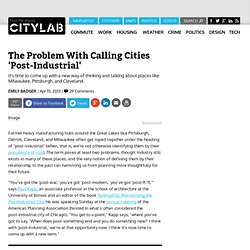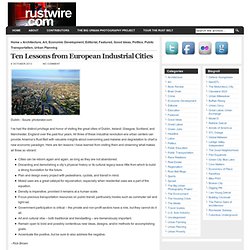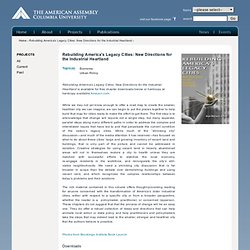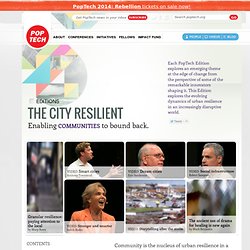

Resiliency vs. sustainability: Can the megacities of the future be both? Photo by Spencer Platt/Getty Images.

This article arises from Future Tense, a partnership of Slate, the New America Foundation, and Arizona State University. On the evening of Wednesday, Oct. 24, Future Tense and Scientific American will be hosting an event in New York City on building resilient cities. To learn more and to RSVP, visit the New America Foundation website. If you've successfully flushed a toilet recently, then you appreciate (at least subconsciously) the workings of a good sewer system. Waste disappears, no matter what time of day or night, or what the weather's like. But weather is actually a challenge for a sewer system, especially precipitation. How does New York do it? The Problem With Calling Cities 'Post-Industrial' Former heavy manufacturing hubs around the Great Lakes like Pittsburgh, Detroit, Cleveland, and Milwaukee often get roped together under the heading of "post-industrial" (when, that is, we're not otherwise identifying them by their prevalence of rust).

The term poses at least two problems, though: Industry still exists in many of these places, and the very notion of defining them by their relationship to the past can hamstring us from planning more thoughtfully for their future. “You’ve got the ‘post-war,’ you’ve got ‘post-modern,’ you’ve got ‘post-9/11,’” says Paul Kapp, an associate professor in the school of architecture at the University of Illinois and an editor of the book SynergiCity: Reinventing the Postindustrial City. He was speaking Sunday at the annual meeting of the American Planning Association (hosted in what's often considered the post-industrial city of Chicago).
Post-industrial society: He said it first. Rust Wire » Blog Archive » Ten Lessons from European Industrial Cities. Home » Architecture, Art, Economic Development, Editorial, Featured, Good Ideas, Politics, Public Transportation, Urban Planning 8 October 2013No Comment Dublin - Soure: photorator.com I’ve had the distinct privilege and honor of visiting the great cities of Dublin, Ireland; Glasgow, Scotland; and Manchester, England over the past four years.

All three of these industrial revolution-era urban centers can provide America’s Rust Belt with valuable insights about overcoming past malaise and degradation to chart a new economic paradigm. Rebuilding America's Legacy Cities: New Directions for the Industrial Heartland. Rebuilding America's Legacy Cities: New Directions for the Industrial Heartland is available for free chapter downloads below or hardcopy at hardcopy available Amazon.com.

While we may not yet know enough to offer a road map to create the smaller, healthier city we can imagine, we can begin to put the pieces together to help build that map for cities ready to make the effort to get there. The first step is to acknowledge that change will require not a single step, but many separate, parallel steps along many different paths in order to address the complex and interrelated issues that have led to and that perpetuate the current condition of the nation’s legacy cities. While much of the “shrinking city” discussion—and much of the media attention it has received—has focused on what to do about these cities’ large and growing inventory of vacant land and buildings, that is only part of the picture and cannot be addressed in isolation.
Alan Mallach. The University of Chicago Urban Network. Cities’ Elusive Quest for a Post-Industrial Future. What do rusting industrial cities have in common with outmoded BlackBerries? In this era of constant technological progress, talent mobility and global competition, it's striking how many similarities can be drawn between cities and companies, and the need for both to continuously adjust their industrial strategies to avoid oblivion or bankruptcy. Cities can lose their vigor and vitality just as surely as a once-hot product can lose its cutting-edge cool.
Urban Environment. ResilientCity Home. Welcome to Making Cities Resilient website. Reaching Resilience. Seven Principles for Big Data and Resilience Projects. The following is a draft “Code of Conduct” that seeks to provide guidance on best practices for resilience building projects that leverage Big Data and Advanced Computing.

These seven core principles serve to guide data projects to ensure they are socially just, encourage local wealth- & skill-creation, require informed consent, and be maintainable over long timeframes. This document is a work in progress, so we very much welcome feedback. Our aim is not to enforce these principles on others but rather to hold ourselves accountable and in the process encourage others to do the same. Initial versions of this draft were written during the 2013 PopTech & Rockefeller Foundation workshop in Bellagio, August 2013. E4 The City Resilient. Community is the nucleus of urban resilience in a world that grows more turbulent with each passing year.

An analysis of almost any crisis strongly supports this notion: In a crunch, people naturally turn toward trusted individuals and institutions. Local knowledge and leadership gain instant currency. Neighbors instinctively help neighbors. This provides a solid conceptual anchor for efforts to improve urban resilience, but raises countless related issues. What is a community? PROFILE. Making cities strong by investing in resilience - Toolkit for resilient cities.